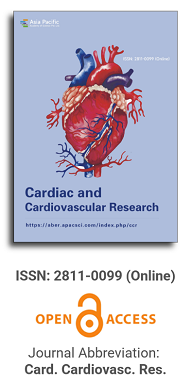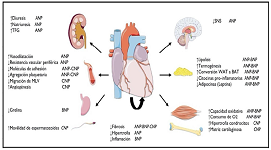
Asia Pacific Academy of Science Pte. Ltd. (APACSCI) specializes in international journal publishing. APACSCI adopts the open access publishing model and provides an important communication bridge for academic groups whose interest fields include engineering, technology, medicine, computer, mathematics, agriculture and forestry, and environment.

Frequency of occurrence of dry mouth in women with high risk of cardiovascular diseases during the menopause
Vol 5, Issue 1, 2024
Download PDF
Abstract
Among the risk factors for dry mouth, or xerostomia, are both estrogen deficiency in women during menopause and the use of medications with xerogenic properties. Until now, it has not been clearly determined, whether dryness in the oral cavity in women during menopause is only associated with subjective sensations or is accompanied by qualitative and quantitative changes in mixed saliva. To determine the frequency and nature of xerostomia syndrome in women during menopause with high and extremely high risk of cardiovascular diseases. The study involved 35 patients (with subjective sensations of dryness in the oral cavity) and 20 apparently healthy women. All study participants were questioned for any dental complaints, and the quantitative indicators of the oral fluid were assessed. An individualized oral hygiene complex and a moisturizing gel were prescribed as correction of the subjective signs of xerostomia. The follow-up visit was carried out after 1 month. The patients in natural menopause felt slight subjective manifestations of dry mouth confirmed by objective decrease in salivary secretion; whereas in most cases subjective dryness in the oral cavity is accompanied by normal secretion. The prescribed complex for correction of dental complaints ensures decrease in the subjective signs of dryness, decrease in taste distortion and halitosis.
Keywords
References
- Halasabalu KS, Gowdappa DV, Tumkur SA, et al. Xerostomia: Current Advancements and Insights in Biomedical and Biotechnology Research. Biomedical and Biotechnology Research Journal. 2024; 8(1): 1–12. doi: 10.4103/bbrj.bbrj_240_23
- Müller F, Chebib N, Maniewicz S, et al. The Impact of Xerostomia on Food Choices—A Review with Clinical Recommendations. Journal of Clinical Medicine. 2023; 12(14): 4592. doi: 10.3390/jcm12144592
- Gibson B, Periyakaruppiah K, Thornhill MH, et al. Measuring the symptomatic, physical, emotional and social impacts of dry mouth: A qualitative study. Gerodontology. 2019; 37(2): 132–142. doi: 10.1111/ger.12433
- Flink H, Tegelberg Å, Arnetz JE, et al. Self-reported oral and general health related to xerostomia, hyposalivation, and quality of life among caries active younger adults. Acta Odontologica Scandinavica. 2019; 78(3): 229–235. doi: 10.1080/00016357.2019.1690677
- Mizuhashi F, Koide K, Toya S, et al. Measurement of Oral Moisture on Oral Dryness Patients. Geriatrics. 2020; 5(2): 28. doi: 10.3390/geriatrics5020028
- Lee KA, Park JC, Park YK. Nutrient intakes and medication use in elderly individuals with and without dry mouths. Nutrition Research and Practice. 2020; 14(2): 143. doi: 10.4162/nrp.2020.14.2.143
- Choo PJ, Taing MW, Teoh L. A retrospective study of drugs associated with xerostomia from the Australian Database of Adverse Event Notifications. International Journal of Pharmacy Practice. 2022; 30(6): 548–553. doi: 10.1093/ijpp/riac051
- Rihab B, Lina EH, Noémie ST, et al. The experience of dry mouth and screening for Sjogren’s syndrome by the dentist: patient-reported experiences. BMC Oral Health. 2023; 23(1). doi: 10.1186/s12903-023-03727-z
- Fukushima Y, Sano Y, Isozaki Y, et al. A pilot clinical evaluation of oral mucosal dryness in dehydrated patients using a moisture-checking device. Clinical and Experimental Dental Research. 2019; 5(2): 116–120. doi: 10.1002/cre2.145
- Ito K, Izumi N, Funayama S, et al. Characteristics of medication-induced xerostomia and effect of treatment. PLOS ONE. 2023; 18(1): e0280224. doi: 10.1371/journal.pone.0280224
- van de Rijt LJM, Stoop CC, Weijenberg RAF, et al. The Influence of Oral Health Factors on the Quality of Life in Older People: A Systematic Review. The Gerontologist. 2019; 60(5): e378–e394. doi: 10.1093/geront/gnz105
- Nappi RE, Kroll R, Siddiqui E, et al. Global cross-sectional survey of women with vasomotor symptoms associated with menopause: Prevalence and quality of life burden. Menopause. 2021; 28(8): 875–882. doi: 10.1097/gme.0000000000001793
- Wang L, Zhu L, Yao Y, et al. Role of hormone replacement therapy in relieving oral dryness symptoms in postmenopausal women: A case control study. BMC Oral Health. 2021; 21(1). doi: 10.1186/s12903-021-01966-6
- de Carvalho HN, dos Santos YL, Bernardino Í de M, et al. Accuracy of a questionnaire on xerostomia as a screening tool for hyposalivation. International Dental Journal. 2020; 70(6): 427–434. doi: 10.1111/idj.12586
- Cydejko A, Kusiak A, Grzybowska ME, et al. Selected Physicochemical Properties of Saliva in Menopausal Women—A Pilot Study. International Journal of Environmental Research and Public Health. 2020; 17(7): 2604. doi: 10.3390/ijerph17072604
- Sardellitti L, Bortone A, Filigheddu E, et al. Xerostomia: From Pharmacological Treatments to Traditional Medicine—An Overview on the Possible Clinical Management and Prevention Using Systemic Approaches. Current Oncology. 2023; 30(5): 4412–4426. doi: 10.3390/curroncol30050336
- American Diabetes Association Professional Practice Committee. Cardiovascular Disease and Risk Management: Standards of Care in Diabetes—2024. Diabetes Care. 2024; 47 (Supplement_1): S179–S218. doi: 10.2337/dc24-S010
- Emelyanova N, Komir I. Effect of drug-induced pathomorphosis on oral cavity organs and tissues in chronic obstructive pulmonary disease combined with coronary heart disease: A clinical case. Biomedical Research and Therapy. 2021; 8(1): 4197–4202. doi: 10.15419/bmrat.v8i1.657
- Nonaka T, Wong DTW. Saliva Diagnostics. Annual Review of Analytical Chemistry. 2022; 15(1): 107–121. doi: 10.1146/annurev-anchem-061020-123959
- Agrawal AT, Hande A, Reche A, et al. Appraisal of Saliva and Its Sensory Perception in Reproductive Transitions of Women: A Review. Cureus. 2022. doi: 10.7759/cureus.31614
- Wulandari P. Effect of Hypoestrogenism on Oral Cavity. Estrogens—Recent Advances. 2023. doi: 10.5772/intechopen.106681
- Langari SF, Hosseini SR, Bijani A, et al. The association between Antihypertensive drugs and oral health-related quality of life in the elderly: Results of Amirkola cohort study. Caspian J Intern Med. 2022; 13(3). doi: 10.22088/cjim.13.3.582
Supporting Agencies
Copyright (c) 2024 Nataliya Emelyanova, Dmitry Emelyanov
License URL: https://creativecommons.org/licenses/by/4.0/

This site is licensed under a Creative Commons Attribution 4.0 International License (CC BY 4.0).

Prof. Prakash Deedwania
University of California,
San Francisco, United States




